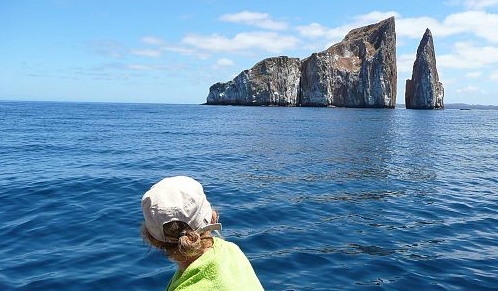
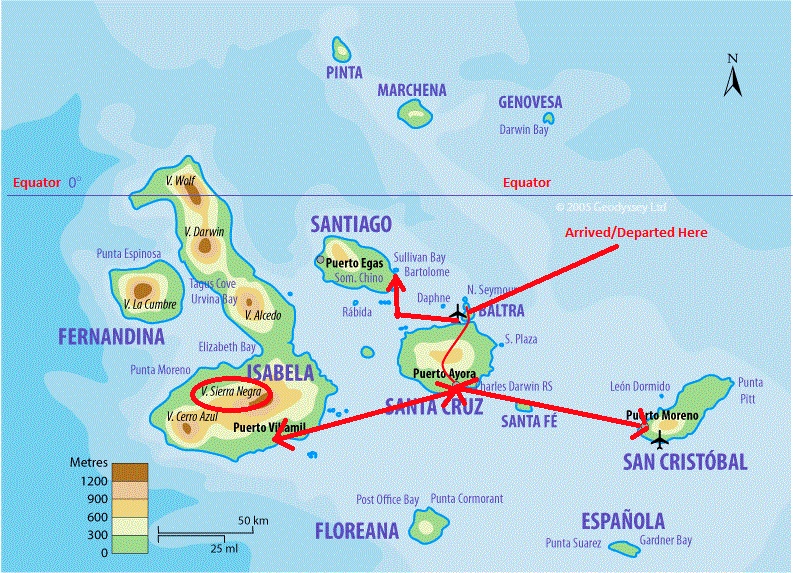 The giant tortoises of Galapagos are among the most famous of the unique fauna of the Islands. While giant tortoises once thrived on most of the continents of the world, the Galapagos tortoises now represent one of the remaining two groups of giant tortoises in the entire world — the other group living on Aldabra Atoll in the Indian Ocean. The largest living species of tortoise, the Galápagos tortoise can weigh over 250 kg (550 lb) and live for over a century. The Galapagos Islands were named for them; the old Spanish word galapago meant saddle, a term early explorers used for the tortoises due to the shape of their shells. There are only 6 mammal species (that can be found on land) that are considered native to the islands.More detailed information on the Galapagos Islands
Perhaps our first association with the word “Galapagos” is the name “Darwin.” Darwin’s visit to the Galapagos Islands had a resounding impact on the formation of his Theory of Natural Selection. He was somewhat surprised to determine the tortoises on each island are different — same species but different physical traits — here’s a great article related to this subject.
The islands are believed to be home to between 552 and 614 native species of native plants and approximately 825 introduced species, the majority introduced by humans. More than 100 of the introduced species have become established in the wild, with many of them extremely invasive and of major concern. Three introduced plant species have been eradicated.
[rev_slider GPSlife]
One of the first animals you will encounter is sea lions — there are 50,000 of them. Then there are Galapagos Fur Seals that are much less abundant in Galapagos than Sea Lions, but their population numbers are similar. Fur Seals typically prefer more rugged, rockier, and shadier shores than sea lions in areas that less likely to be frequented by people. Whereas the Sea Lions hang out on beaches, docks, streets, hotel pools, etc., the Fur Seals can be viewed in places like Kicker Rock (below). Many species of whales hang out in the Galapagos Marine Reserve, including the Sperm Whale, Killer Whale, False Killer Whales, the Pilot Whale, as well as several species of dolphins. There are two dolphin species that I encountered off Pinnacle Rock — Bottle-nosed Dolphin and the Common White-bellied Dolphin.
More Reasons to travel to the Galapagos my way
The giant tortoises of Galapagos are among the most famous of the unique fauna of the Islands. While giant tortoises once thrived on most of the continents of the world, the Galapagos tortoises now represent one of the remaining two groups of giant tortoises in the entire world — the other group living on Aldabra Atoll in the Indian Ocean. The largest living species of tortoise, the Galápagos tortoise can weigh over 250 kg (550 lb) and live for over a century. The Galapagos Islands were named for them; the old Spanish word galapago meant saddle, a term early explorers used for the tortoises due to the shape of their shells. There are only 6 mammal species (that can be found on land) that are considered native to the islands.More detailed information on the Galapagos Islands
Perhaps our first association with the word “Galapagos” is the name “Darwin.” Darwin’s visit to the Galapagos Islands had a resounding impact on the formation of his Theory of Natural Selection. He was somewhat surprised to determine the tortoises on each island are different — same species but different physical traits — here’s a great article related to this subject.
The islands are believed to be home to between 552 and 614 native species of native plants and approximately 825 introduced species, the majority introduced by humans. More than 100 of the introduced species have become established in the wild, with many of them extremely invasive and of major concern. Three introduced plant species have been eradicated.
[rev_slider GPSlife]
One of the first animals you will encounter is sea lions — there are 50,000 of them. Then there are Galapagos Fur Seals that are much less abundant in Galapagos than Sea Lions, but their population numbers are similar. Fur Seals typically prefer more rugged, rockier, and shadier shores than sea lions in areas that less likely to be frequented by people. Whereas the Sea Lions hang out on beaches, docks, streets, hotel pools, etc., the Fur Seals can be viewed in places like Kicker Rock (below). Many species of whales hang out in the Galapagos Marine Reserve, including the Sperm Whale, Killer Whale, False Killer Whales, the Pilot Whale, as well as several species of dolphins. There are two dolphin species that I encountered off Pinnacle Rock — Bottle-nosed Dolphin and the Common White-bellied Dolphin.
More Reasons to travel to the Galapagos my way
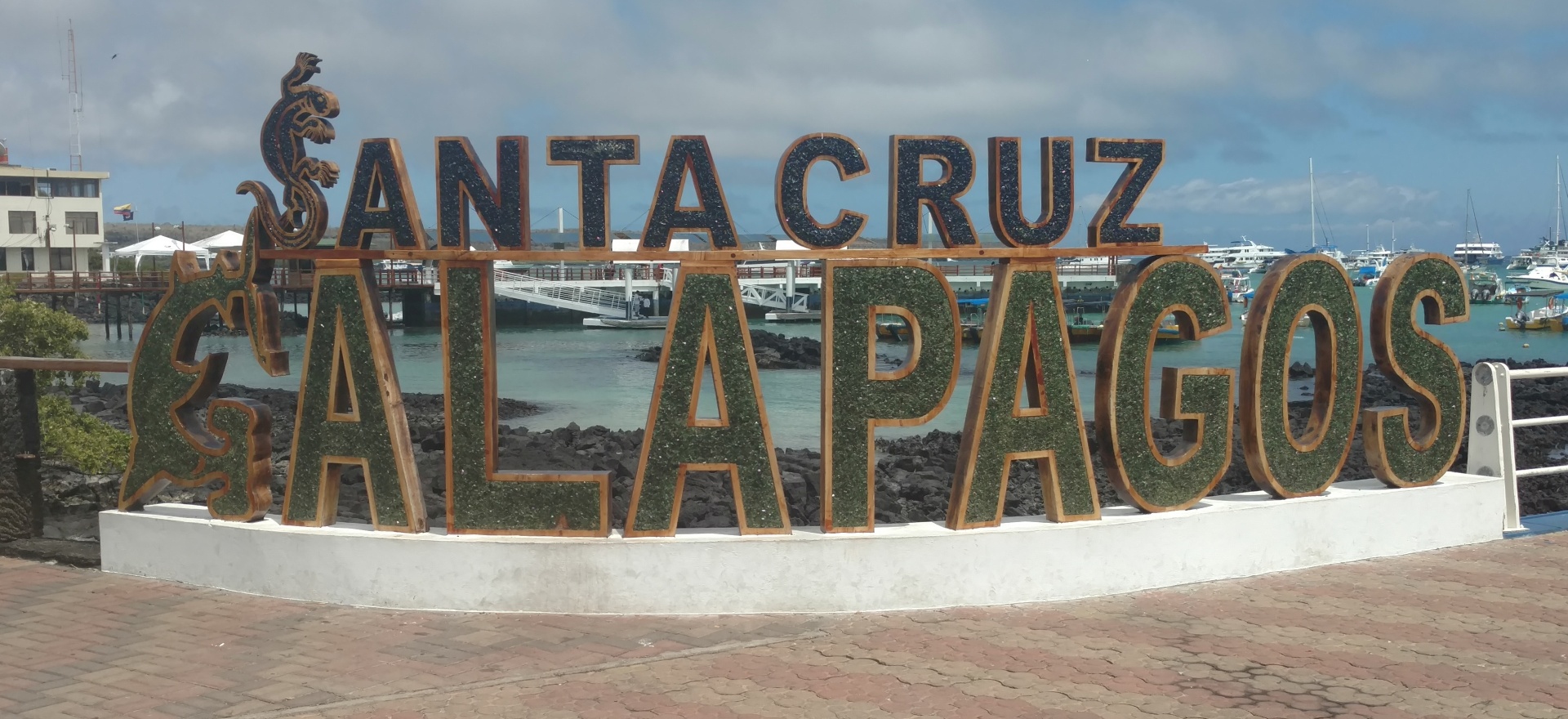 The center of Santa Cruz is much more lush than the coastal areas because highlands catch the rain clouds. You could take a taxi from the arrival point on the north side of the island but I chose a government bus to the bustling town of Puerto Ayora — it is the biggest town on the islands and reminds me of a Mexican resort. There are 4 inhabited islands of which I visited and stayed for 3 nights on 3 islands: Santa Cruz, Isabela & San Christobal — the fourth island, Floreana, is inhabited by 110 1/2 (February, 2018) people but is a slightly longer boat ride from Puerto Ayora (my gateway). Galapagos Slideshow
The center of Santa Cruz is much more lush than the coastal areas because highlands catch the rain clouds. You could take a taxi from the arrival point on the north side of the island but I chose a government bus to the bustling town of Puerto Ayora — it is the biggest town on the islands and reminds me of a Mexican resort. There are 4 inhabited islands of which I visited and stayed for 3 nights on 3 islands: Santa Cruz, Isabela & San Christobal — the fourth island, Floreana, is inhabited by 110 1/2 (February, 2018) people but is a slightly longer boat ride from Puerto Ayora (my gateway). Galapagos Slideshow
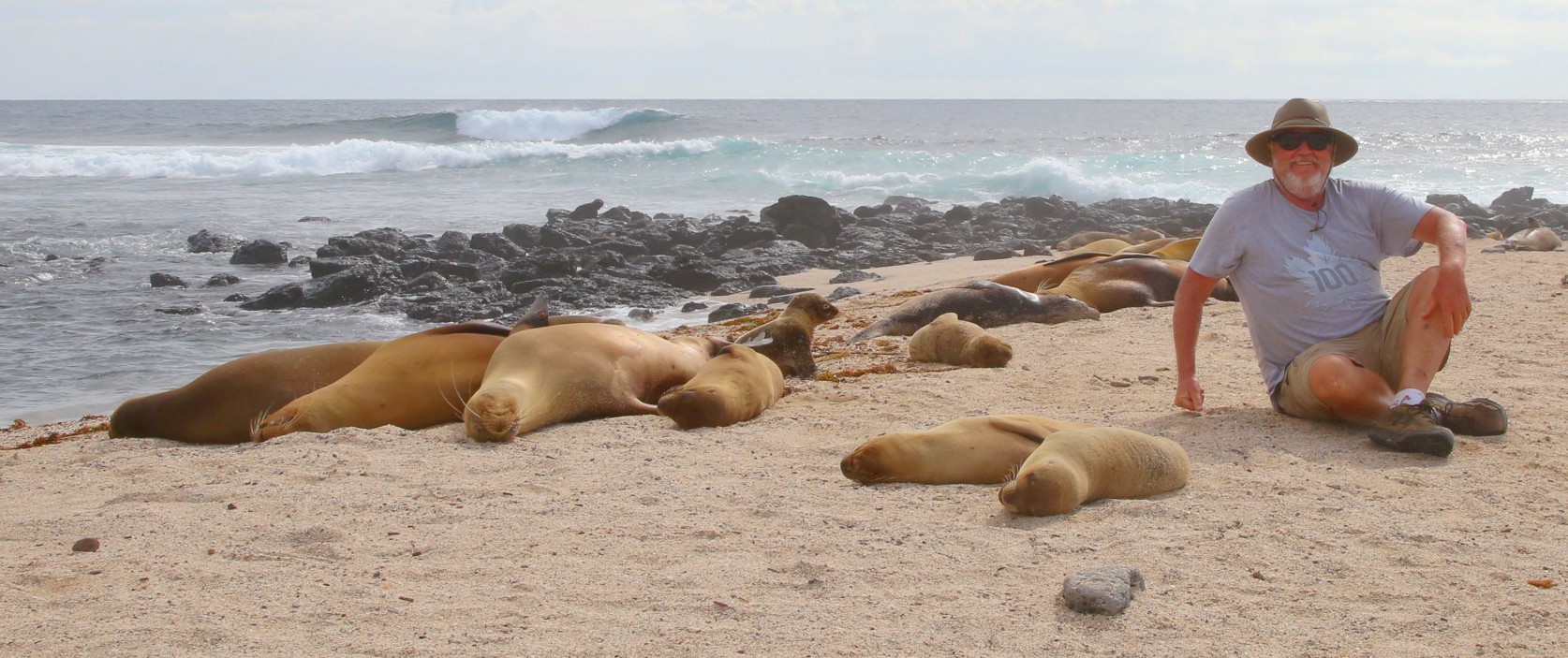 The Galapagos archipelago is located at a point where major ocean currents come together, mingling nutrient rich cool waters from the south, warm currents from the north, and a deep cold current from the west. This convergence of ocean currents has combined flora and fauna from contrasting environments, and given rise to unique marine species. Nearly 20% of marine life in Galapagos is endemic, found nowhere else on earth. This level of endemism is rare for marine species, which tend to migrate and intermingle to a much larger degree than terrestrial (land-based) species.
The Galapagos archipelago is located at a point where major ocean currents come together, mingling nutrient rich cool waters from the south, warm currents from the north, and a deep cold current from the west. This convergence of ocean currents has combined flora and fauna from contrasting environments, and given rise to unique marine species. Nearly 20% of marine life in Galapagos is endemic, found nowhere else on earth. This level of endemism is rare for marine species, which tend to migrate and intermingle to a much larger degree than terrestrial (land-based) species.
 Blue Footed Boobie
The creatures on the islands don’t seem to have any fear of humans. You don’t need a fancy zoom lens to take amazing pictures. Mockingbirds, warblers and sea lions come right up to you, and in places, it’s hard not to step on the marine iguanas: they don’t get out of the way. It’s weird.
Blue Footed Boobie
The creatures on the islands don’t seem to have any fear of humans. You don’t need a fancy zoom lens to take amazing pictures. Mockingbirds, warblers and sea lions come right up to you, and in places, it’s hard not to step on the marine iguanas: they don’t get out of the way. It’s weird.
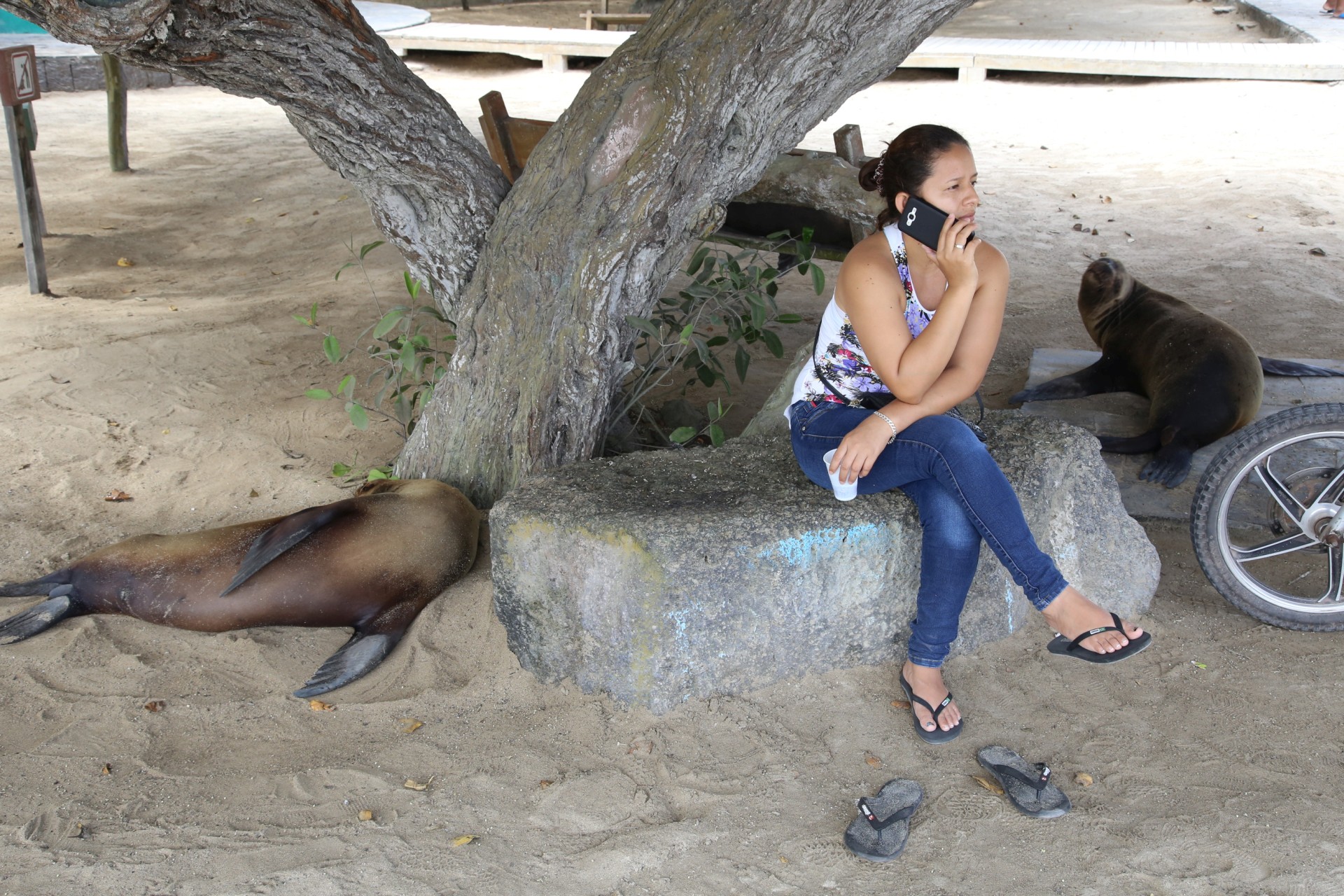
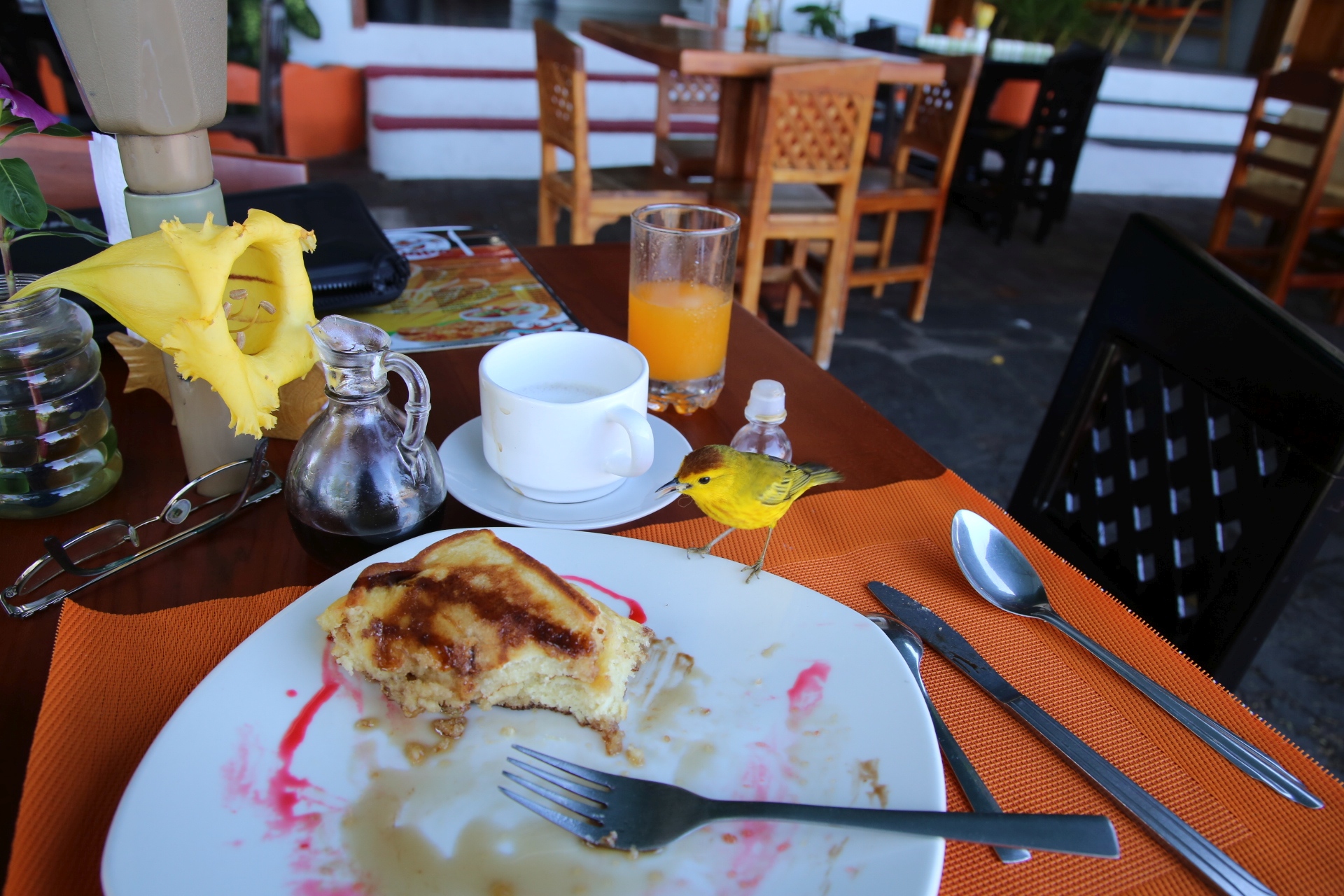 Yellow Warbler taking an interest in my pancake
The Galapagos is a “hot spot”. Hot spots occur when one of the Earth’s plates moves over an unusually hot part of the Earth’s mantle. These hot areas are usually relatively stationary and result in large amounts of magma rising up, piercing a hole in the plate to form a volcano. As the plates move, a series of volcanoes can form. This is how the Galapagos Islands were formed. The islands are covered with volcanoes. The South American plate collides with the Nazca plate with a southerly movement of 11cm per year. Over thousands of years volcanoes are created in a different but close proximity to the older ones (Note the 6 volcanoes on Isabela on the map above where Sierra Negra is the newest one which last erupted in 2005 (which I hiked around — see below).
Video– Lava Tunnels on the south shore of Isabela
Video– More Lava Tunnels on the south shore of Isabela
Yellow Warbler taking an interest in my pancake
The Galapagos is a “hot spot”. Hot spots occur when one of the Earth’s plates moves over an unusually hot part of the Earth’s mantle. These hot areas are usually relatively stationary and result in large amounts of magma rising up, piercing a hole in the plate to form a volcano. As the plates move, a series of volcanoes can form. This is how the Galapagos Islands were formed. The islands are covered with volcanoes. The South American plate collides with the Nazca plate with a southerly movement of 11cm per year. Over thousands of years volcanoes are created in a different but close proximity to the older ones (Note the 6 volcanoes on Isabela on the map above where Sierra Negra is the newest one which last erupted in 2005 (which I hiked around — see below).
Video– Lava Tunnels on the south shore of Isabela
Video– More Lava Tunnels on the south shore of Isabela
 Lava Tunnels on the south shore of Isabela overgrown with organ cactus
The Galapagos Islands are home to the world’s only marine iguana and the most northern-living penguin. Coral beds share the same waters as fur seals. Galapagos is one of the only places where pelagic species (species that live neither close to the bottom of the ocean nor near the shore) such as tunas, manta rays, and hammerhead sharks can be seen close to shore. No other site in the world showcases such a diversity of marine life forms.
Lava Tunnels on the south shore of Isabela overgrown with organ cactus
The Galapagos Islands are home to the world’s only marine iguana and the most northern-living penguin. Coral beds share the same waters as fur seals. Galapagos is one of the only places where pelagic species (species that live neither close to the bottom of the ocean nor near the shore) such as tunas, manta rays, and hammerhead sharks can be seen close to shore. No other site in the world showcases such a diversity of marine life forms.

 Marine Iguanas are not pretty creatures
Additionally, geological and biological processes in Galapagos have helped create a high variety of habitats relative to other marine areas in the eastern Pacific. Coastal areas include vertical cliffs, sandy beaches, rocky shores, mangroves, coral reefs, lagoons, and salt flats. Submarine mountains, plateaus, ridges, and valleys provide habitat to an array of marine communities, while the open ocean waters attract stocks of pelagic fish.
Marine Iguanas are not pretty creatures
Additionally, geological and biological processes in Galapagos have helped create a high variety of habitats relative to other marine areas in the eastern Pacific. Coastal areas include vertical cliffs, sandy beaches, rocky shores, mangroves, coral reefs, lagoons, and salt flats. Submarine mountains, plateaus, ridges, and valleys provide habitat to an array of marine communities, while the open ocean waters attract stocks of pelagic fish.

 Rim of the Sierra Negra Volcano (Ecuadorian tourist from Guayaquil)
Rim of the Sierra Negra Volcano (Ecuadorian tourist from Guayaquil)
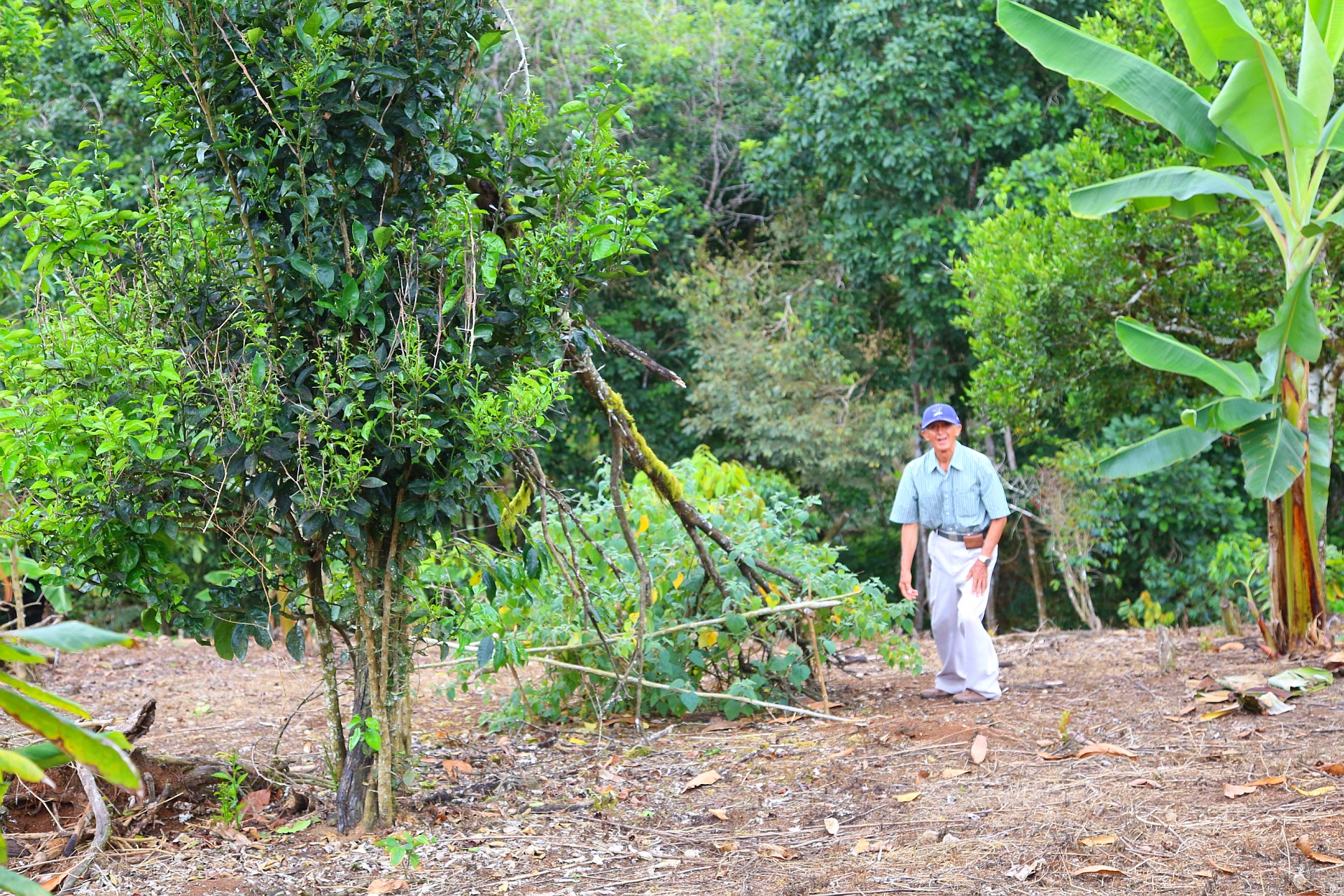 Pepe Admiring Touring his Property
Pepe Admiring Touring his Property
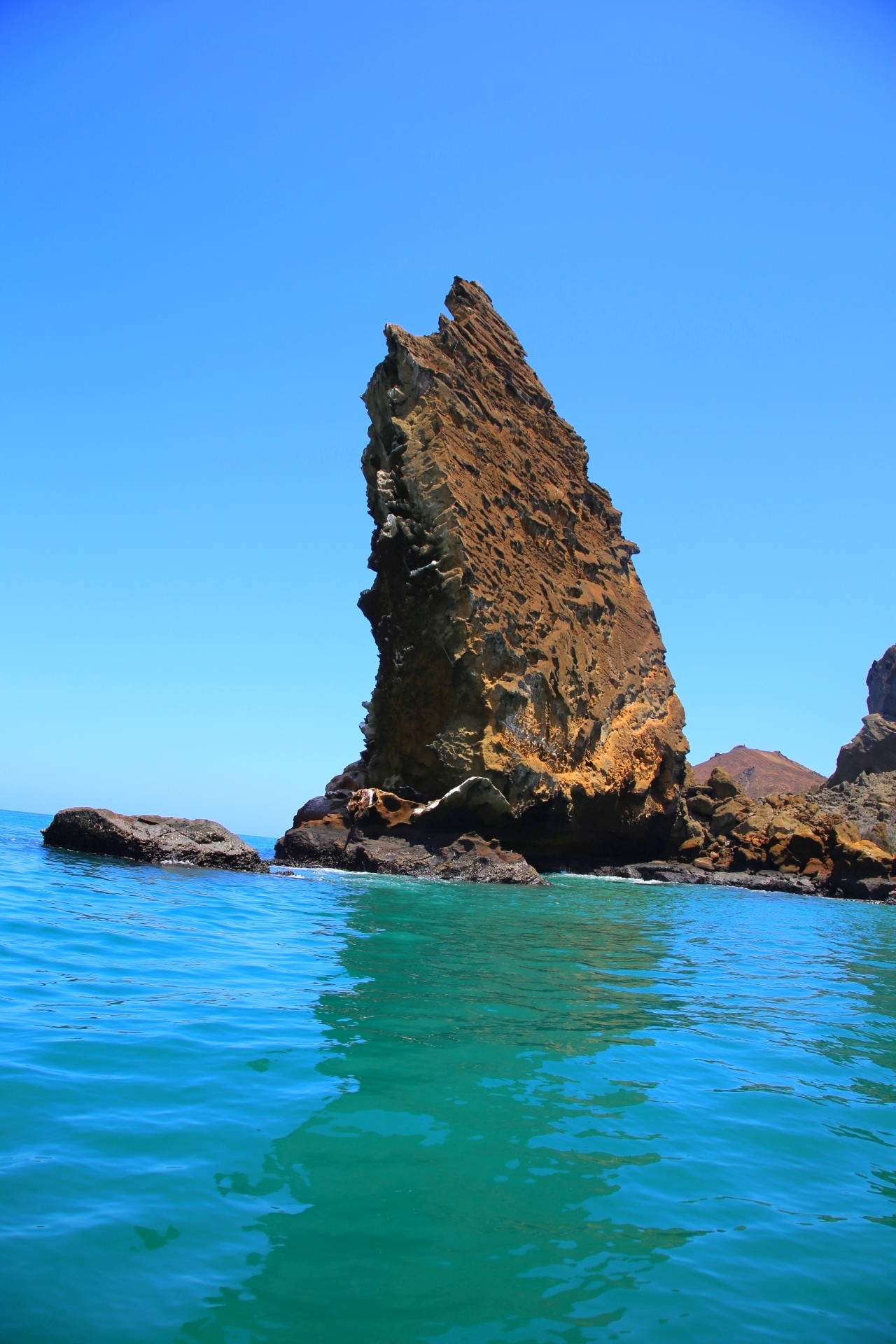
 Sparse Bartolome Landscape with rich underwater wildlife
Sparse Bartolome Landscape with rich underwater wildlife
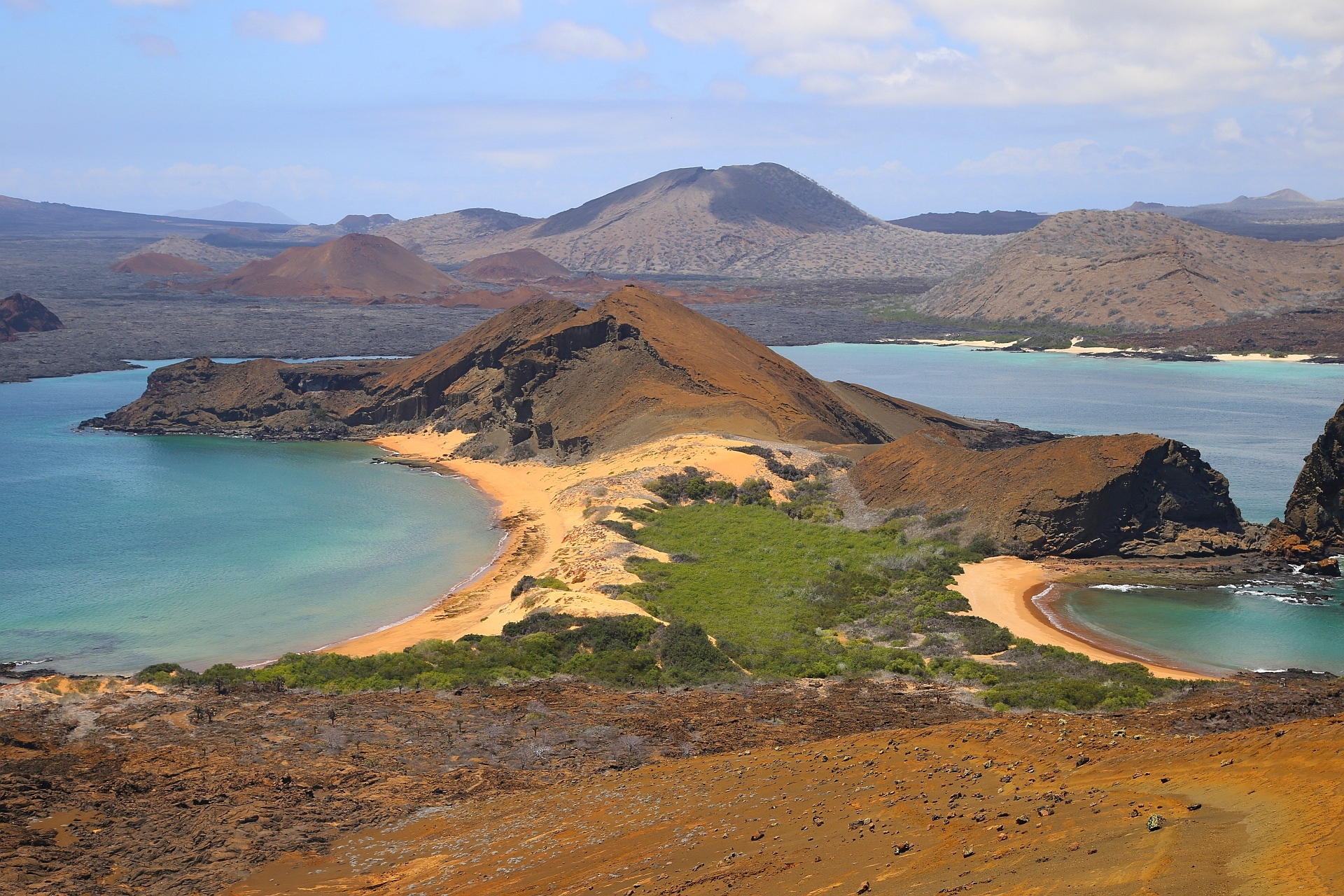 Postcard view from the top of Bartolome Peak
Postcard view from the top of Bartolome Peak
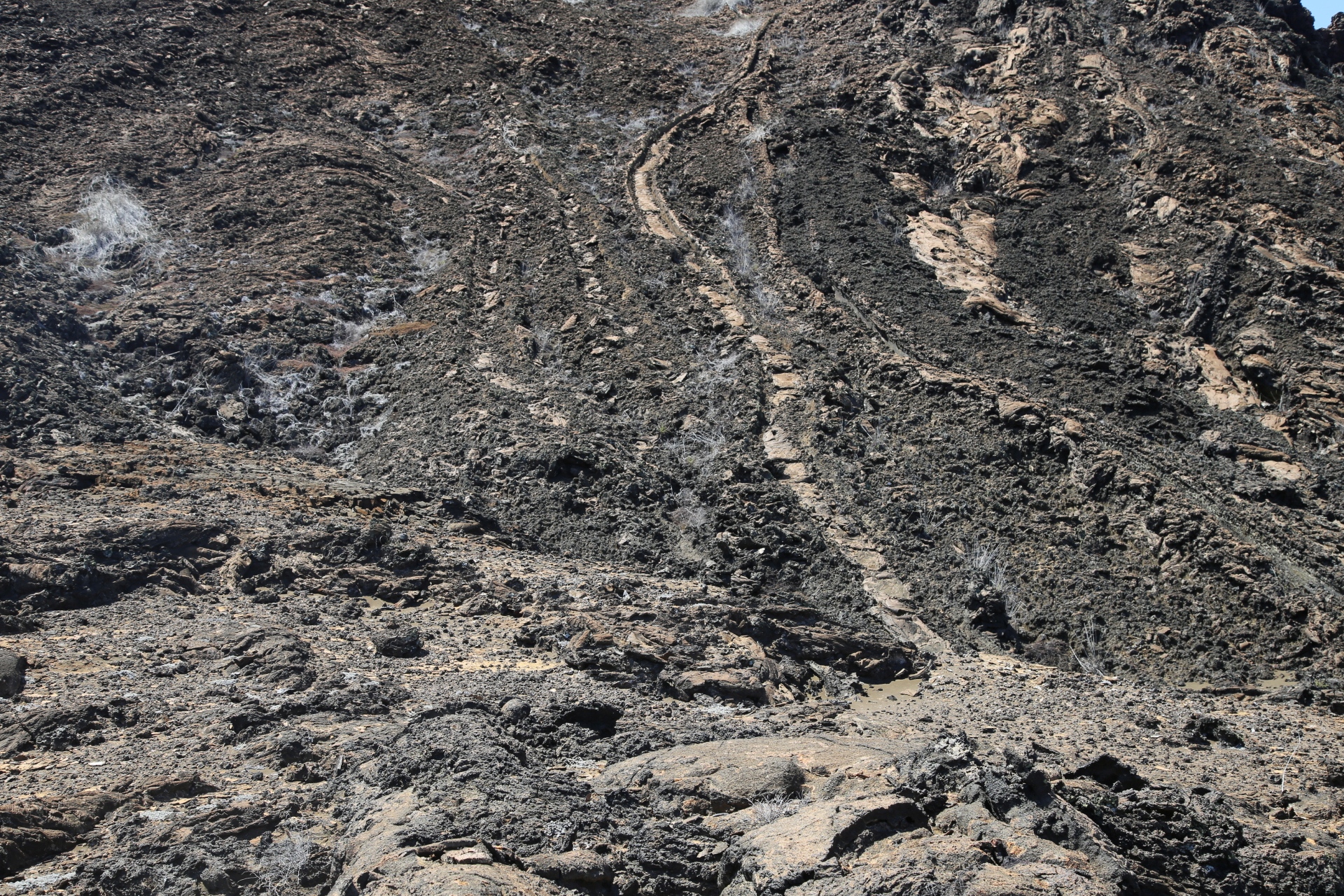 Lava Flow (estimated to be from the 16th century)
Lava Flow (estimated to be from the 16th century)
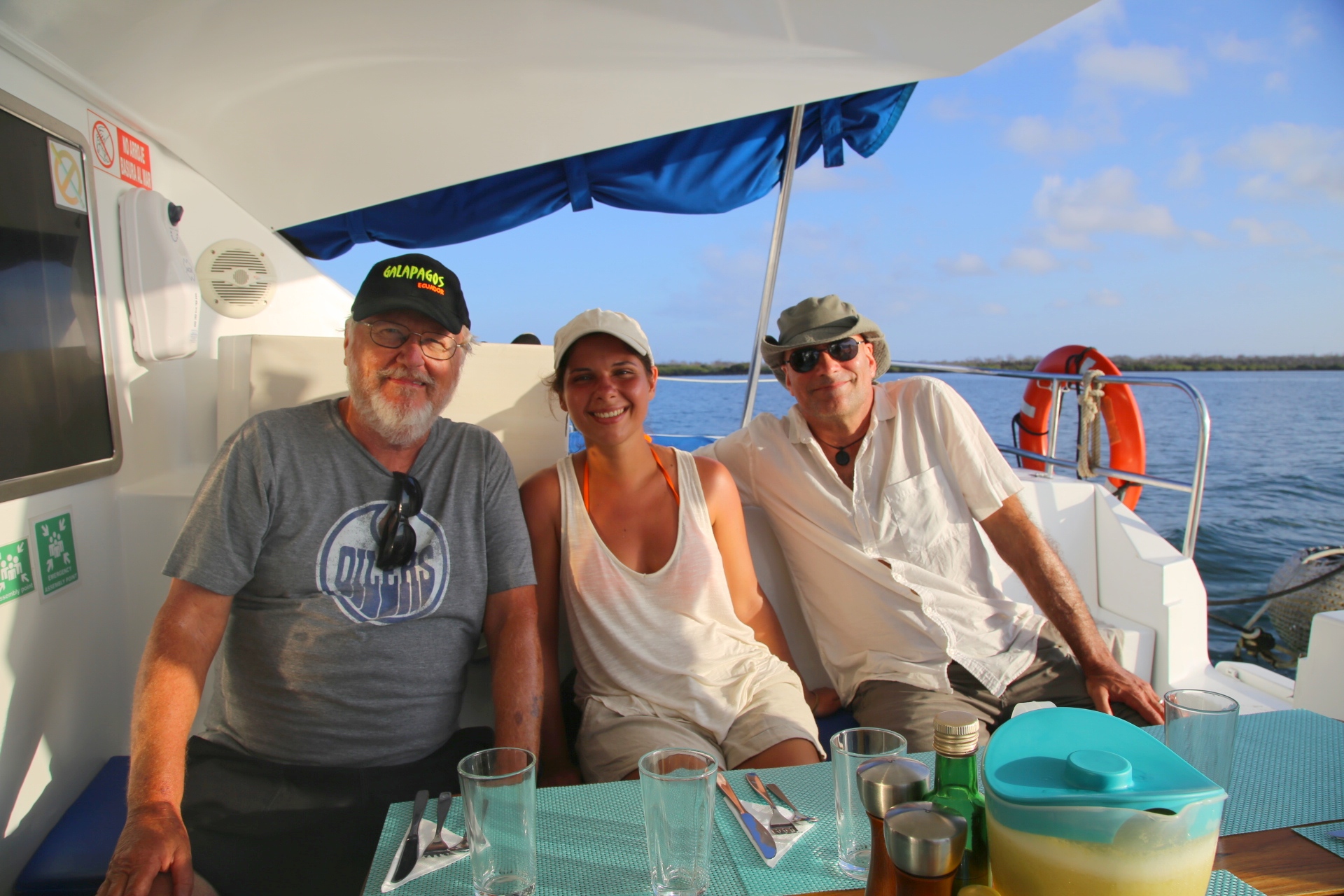 New friends on Bartolome Catamaran Daytrip
A complete guide to traveling to the Galapagos
New friends on Bartolome Catamaran Daytrip
A complete guide to traveling to the Galapagos